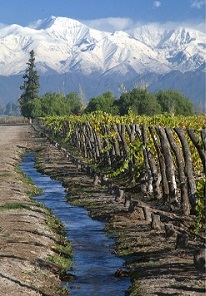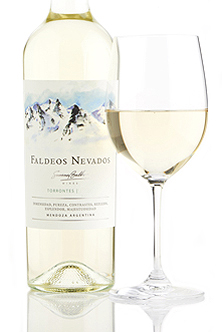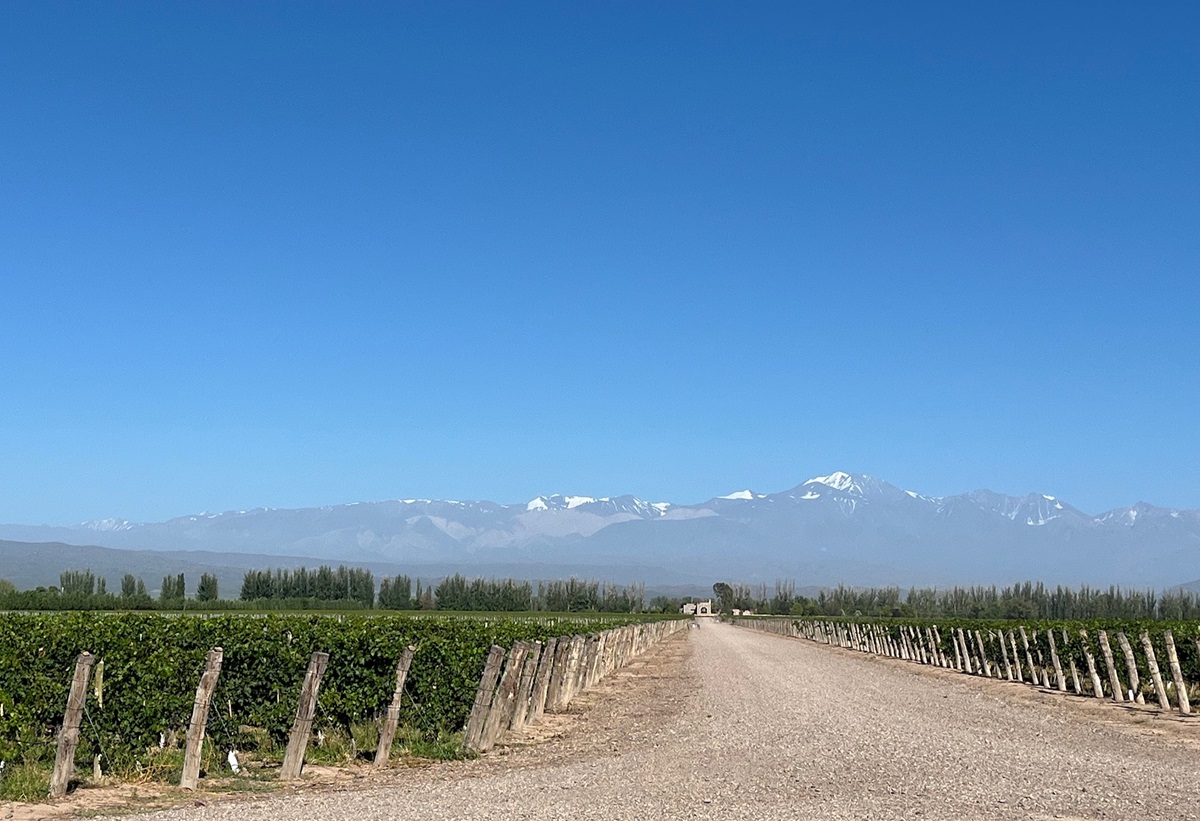BREAKING NEW GROUND

By Rose Murray Brown MW Published in The Scotsman 16 November 2019
‘Breaking New Ground’ was the rather apt title of an Argentinian wine tasting I attended recently. Unusually for Argentina, there was not a Malbec, Merlot or Cabernet Sauvignon in sight – the wines were all white.
On my past trips to Argentina I have been a bit disappointed with their whites – but felt Torrontes, Chenin Blanc and Semillon had potential. Now the white wine renaissance is just starting, although still a long way behind neighbour Chile qualitywise, Argentina has more potential terroir to explore and plant.
“In the past Chardonnay was grown in warm areas, but now growers are heading north, south, east, west and higher up into the Andes”, says Phil Crozier of Wines of Argentina. “The biggest pace for change for whites has been a focus on cooler areas with greater diurnal temperature shift to give freshness alongside ripe fruits – and a better understanding of harvest dates, soils and regions”, he says.
 “I wince when I think of the Argentinian whites I used to sell when they first emerged in the UK”, says Crozier. I would agree with him. I remember Argentinian whites of thirty years ago were flabby, unbalanced, overoaked or slightly oxidized. Their economic climate has never been stable, but when wineries were able to invest in refrigeration and stainless steel, the whites swung the other way to become too-clean zippy cool-fermented styles. Now they are finding a middle ground with more elegance, richness and balance.
“I wince when I think of the Argentinian whites I used to sell when they first emerged in the UK”, says Crozier. I would agree with him. I remember Argentinian whites of thirty years ago were flabby, unbalanced, overoaked or slightly oxidized. Their economic climate has never been stable, but when wineries were able to invest in refrigeration and stainless steel, the whites swung the other way to become too-clean zippy cool-fermented styles. Now they are finding a middle ground with more elegance, richness and balance.
A new generation of well-travelled winemakers are also looking at Argentina’s past – pre 1980’s – as the country has 450 years of wine history. Some are reverting back to using concrete to save energy as steel tanks require constant expensive refrigeration, some experiment with Chardonnay aged under flor yeast.
“Less reliance on oak is another key change”, says Crozier. “More experimentation with larger oak foudres, to aid complexity without oak flavour, concrete and clay, as well as wild yeasts and less intervention now the norm. Whilst in the vineyard ‘precision viticulture’ – being clever about how they use precious mountain water for irrigation – is essential”, he says.
We now have a host of new IG (Indicacion Geografica) subregions to look for on labels. With names like Chacayes and San Pablo in Mendoza new this year – and emerging regions like the most southerly vineyards of subzone Chubut – and most easterly, Atlantic Coast.
“Unlike other wine countries, Argentina’s soils are constantly changing with earthquakes and ferocious strong winds, so growers are alert to terroir changes”, says Crozier. Another risk is hail – many vineyards are netted – and each year 30% of the country’s vineyards are damaged by hail.
When it comes to white grapes, Torrontes is Argentina’s calling card. This pungent aromatic grape (a grape cross between Muscat de Alexandria and Listan Prieto) is at its best with a bouquet of roses and white blossom – and at its worst, cheap perfume. It is becoming harder to find a bad Torrontes now as many grow the Riojano clone planted at high altitude – at 2,200 metres in the case of breathtakingly beautiful Cafayate valley in Salta,
Tastewise, Torrontes is like a Gewurztraminer and Sauvignon Blanc cross with pungent nose and crisp palate, which might appeal to Italian Pinot Grigio or New Zealand Sauvignon drinkers. Torrontes typically comes in two versions: unoaked zippy and fresh (Colome Torrontes is a good example) and oaked versions from older vines (like El Esteco’s Old Vines 1945). Both work well with Asian food and Peruvian ceviche.
One of the best examples of a classic Chardonnay is Salentein’s single vineyard example from a 2000m high vineyard in San Pablo, Tunuyan. One of the funkiest is Zuccardi’s ‘Fosil’ Chardonnay (£50), from soils with high levels of calcium carbonate made using wild indigenous yeasts with fermentation in large oak foudres.
Sauvignon Blanc has potential, particularly interesting when grown at high altitude. Riesling is interesting, but plantings small, and some are trying to coax flavours from the wider-grown Pedro Gimenez (no relation of Spain’s PX). Austria’s Gruner Veltliner shows promise, introduced to Patagonia in the south to make sparkling wines, it tastes different from Austrian examples.
One of Argentina’s greatest strengths is the age of some of its vines. There is a wealth of old vine Semillon and Chenin Blanc – but sadly quite a bit has been regrafted to Malbec.
According to Crozier, the biggest future for white grapes is in blending. Indeed one of the best wines I tasted was an old vine blend of Semillon, Sauvignon Blanc and Torrontes from San Carlos in Mendoza made by Argentina’s finest white winemaker Susana Balbo – the first woman to graduate in oenology in Argentina.
TASTE TEST:
Mendoza: SANTA JULIA ORGANIC TORRONTES 2018
(£6.99 reduced from £9.39 until 3 Dec Waitrose)
Light mango, peachy with creamy weight and dry zippy finish – not best example of Torrontes I have tasted, but undoubtedly a bargain at its knockdown price.
 Mendoza & Salta: FALDEOS NAVADOS TORRONTES 2018 Susana Balbo ***STAR VALUE***
Mendoza & Salta: FALDEOS NAVADOS TORRONTES 2018 Susana Balbo ***STAR VALUE***
(£8.95 The Wine Society)
Popular with tasters for its light rosepetal perfume, fresh zippy youthful unoaked crispness and ripe citric zesty core, slightly off dry, quite heady at 14% – from Argentina’s most experienced winemaker, Susana Balbo.
Calchaqui, Salta: TORRONTES 2019 Colome
(£11.70 Exel Wines; Fine Wine Co; The Drink Shop)
Floral notes, nectarine and grapefruit flavours, citric undertones and vibrant acidity from one of Salta’s oldest wineries.
Cafayate, Salta: TORRONTES RIESLING 2018 Amalaya
(£10.95-£11.99 Aitken Wines; Henderson Wines; Valvona & Crolla; Cornelius Wine; Exel Wine)
Torrontes and Riesling work well together with pungent lychees and tropical fruit notes and zippy minerally finish – ideal for spicy prawn dish or aperitif.
Uco Valley, Mendoza: GRUNER VELTLINER 2018 Norton ***STAR BUY***
(£11.69 www.allaboutwine.co.uk; www.hic-winemerchants.com)
Sweet ripe greengage nose, spicy, richer and fatter than Austrian examples; interesting potential.
Agrelo, Mendoza: PRIMERA REVANCHA CHENIN BLANC 2018
(£12.50 The Wine Society)
Old vine Chenin Blanc with enchanting honey and hazelnut bouquet, vibrant acid, herby undertones, creamy textural palate, a touch too heavy on oak – but still a lovely example of the grape.
Uco Valley, Mendoza: SIGNATURE WHITE BLEND 2017 Susana Balbo ***STAR BUY***
(£17.99 Hennings Wine; Exel Wine; Field & Fawcett)
Quirky blend of Semillon, Sauvignon Blanc and Torrontes from new Paraje Altamira IG, lovely complexity, citric grapefruit notes, rich textured, soft oak notes
Uco Valley, Mendoza: SINGLE VINEYARD CHARDONNAY 2016 Salentein
(£25 Corking Wines; Matthew Clark)
Rich intense classic, intense nutty, citrus flavours, long finish from new San Pablo IG – one of Argentina’s best Chardonnays.
Rio Negro, Patagonia: OLD VINES SEMILLON 2019 Riccitelli ***STAR BUY***
(£31.95 Exel Wines; Old Bridge Wine)
My favourite from Matias Riccitelli’s promising range; rich intense honeyed creamy elegant Semillon from vines planted in 1950’s matured in oak and concrete eggs.
Buy a gift voucher for Rose’s wine tastings in Edinburgh, Glasgow & St Andrews from £40 www.rosemurraybrown.com
wine tastings
The perfect gift for the wine enthusiast in the family. Rose does In-person tastings too.
cellar advice
Rose does cellar valuations for private clients, valuations for insurers & bespoke portfolio management.
Related stories
March 31, 2024
By Rose Murray Brown MW Published in The Scotsman 30 March 2024 On 2 February 1659, the first wine made from grapes grown in South Africa was crafted by the Governor of the Cape, Jan van Riebeeck. He had planted vines four years earlier in the Company’s Garden near Cape Town from cuttings imported from France. Van Riebeeck’s first
March 24, 2024
By Rose Murray Brown MW Published in The Scotsman 16 March 2024 Heatwaves and bushfires were very much on the agenda when I visited Chile last month as winemakers prepared for their 2024 harvest in blistering heat and drought, with a plume of smoke from the devastating fires lingering over coastal hills. Heat and drought are the greatest challenges
March 23, 2024
By Rose Murray Brown MW Published in The Scotsman 9 March 2024 I have two glasses of Malbec in my hands from the same high-altitude vineyard in Uco valley in Argentina. I am in the Catena Institute of Wine in Mendoza with winemaker Agustin Silva. He has asked me to taste the two wines, both from the 1500m high



